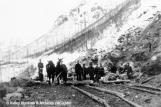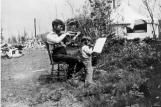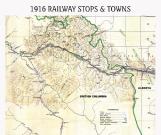2
From 1910-1914, L.J. Cole was a surveyor and resident engineer during the construction of the Grand Trunk Pacific railway. Bud and his mother Bertha accompanied him, living in tents for a couple of years until there was track laid. Then a box car accommodation became available and seemed a luxury. A baby brother arrived during those years, but Bud said that his mother did not seem to consider her life a hardship, but enjoyed walks, fishing and her husband's music and photography.3
GTP ticket discovered among the possessions of Wilfred A. Jowett.1914
Yellowhead Pass, British Columbia, Canada

4
The Yellowhead Pass was considered the easiest passage through the Canadian Rockies, but there was no major transportation until 1911. The Canadian Pacific Railway intended to use the route to build the first transcontinental railway in 1872, but changed plans. By 1907 there were two railroads surveying the area.This ticket was discovered among the possessions of Wilfred D. Jowett, son of William A. Jowett, a magistrate at Tete Jaune in the 1913 - 1915 era.
6
The Grand Trunk Pacific (GTP) was the first railway to run through the Yellowhead Pass. The final spike was driven into the rail in 1914. The Canadian Northern Railway (CNoR) was close behind the GTP. In some places, the tracks ran side by side as the valley only offered one place to build a railroad. The CNoR line was completed in January of 1915.7
Railway construction: Engineer Cole and crew near Tete Jaune Cache1911-1916
Tete Jaune Cache, British Columbia, Canada
 Credits:
Credits:P996.7.2.24 / Ted Williams Collection
The Exploration Place (Prince George)
8
The construction of the railroad through the Robson Valley consisted of four major parts. First, surveyors travelled the land to determine the best path for the railroad.9
Railway construction: by horse and stoneboat1911-1916
Tete Jaune Cache, British Columbia, Canada
 Credits:
Credits:Cole Collection
Valley Museum and Archives (McBride)
10
The next step: Men made a simple roadbed along the proposed line by varied methods, such as dynamite, steam shovel, and hand shovel.11
Tracklayer Pioneer used during railway construction1911-1916
Tete Jaune Cache, British Columbia, Canada
 Credits:
Credits:Cole Collection
Valley Museum and Archives (McBride)
12
The ties and rails were then laid on the roadbed with a tracklayer. Finally, section men ballasted the rails, jacking up the rails and shoving gravel under, to even and strengthen the rail. The burnt trees in the picture were the result of inconsiderate road clearing that caused widespread forest fires.Prior to the building of the railroad, the survey and road crews needed food, dynamite and horses. Tote roads (rough trails) were constructed to haul freight by mules. The tote roads cost $1,000 per mile to build.
13
The building of a transcontinental railway in Canada1910
Tete Jaune Cache, British Columbia, Canada
 Credits:
Credits:Produced by Butcher's Empire Pictures, London
Distributed by CFI; Cleared for use (copyright expired 2001; National Film, TV and Sound Archives)
14
Bootlegging whiskey at Tete JauneTete Jaune Cache, British Columbia, Canada
 Credits:
Credits:Mildred Tillberg

